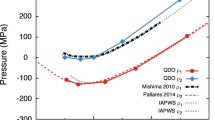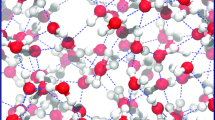Summary.
Following a critical survey of the vast recent literature, the state of the art may be summarized as follows:
(A) Water structure. The key is appreciating the next-nearest neighbour aspect. Thus, liquid water may be conceived as a fluctuating mixture of broadly two groups of structure elements: (i) an open ice-Ih-type outer neighbour bonding at about 4.5 Å and (ii) a dense ice-II-type outer neighbour bonding at about 3.4 Å. On the other hand, the nearest neighbour distance of about 2.8 Å and the number of these neighbors (4) is very similar in the solid and liquid state. The characterization of the two states may be directed either by the geometry of the H-bonds (more linear H-bonds in (i) and more bent H-bonds in (ii) or by the bonding forces operating (H-bonding favours the ordered open state (i), oxygen–oxygen interactions favour the random dense state (ii). Basically, the nature of liquid water can be understood in terms of a competition between H-bond (Coulomb) and dispersion (van der Waals) forces. Since the bonding characteristics in crystalline phases carry over to the liquid state, any molecular dynamics (MD) model of the liquid would have first of all to reproduce well the ice polymorph structures under appropriate thermodynamic conditions.
(B) Hydrophobic effect. The two classic approaches, i.e. the clathrate cage model and the cavity-based model, appear to be just different perspectives on the same physics. The particular features of water are (i) the small molecular size or, more specifically, the small size of the space between water molecules and the low expansibility, and (ii) the structure of the water molecule with the same number of donor and acceptor sites arranged tetrahedrally. Due to (i), cavity formation is particularly demanding, and this is the main contributor to the hydrophobic effect. This is mitigated by the capability of water, due to (ii), to form a cage around a nonpolar solute without sacrificing much of the H-bonding; rather, H-bonding networks are stabilized by the presence of guest molecules. In view of the tangential orientation of the first-sphere waters, such a cage can be compared with an elasticated net effecting strong solute–solvent dispersive interactions, rendering the solubility of nonpolar gases exothermic at room temperature. Furthermore, cavity formation largely determines the excess entropy, whereas dispersive forces determine the excess enthalpy. This gives rise to compensation behaviour when the solute size varies. Whereas an increase in solute size enhances the cavity formation energy, polarizability is also increased, and this leads to stronger solute–water interaction. Unfortunately, present models of cavity formation predict positional entropies that are far in excess of the experimental entropies so that orientational contributions due to cage formation are hard to accommodate.
(C) Like-dissolves-like rule. The number of exceptions is dramatically reduced if the term polarity is given a broader meaning. Instead of identifying it solely with dipolarity, it should also include higher multipolar properties, in particular quadrupolarity. Quadrupolar solvent effects on solvation and reactivity are receiving increasing attention, particularly in low dielectric solvents.
Similar content being viewed by others
Author information
Authors and Affiliations
Additional information
Received May 8, 2001. Accepted (revised) May 23, 2001
Rights and permissions
About this article
Cite this article
Schmid, R. Recent Advances in the Description of the Structure of Water, the Hydrophobic Effect, and the Like-Dissolves-Like Rule. Monatshefte fuer Chemie 132, 1295–1326 (2001). https://doi.org/10.1007/s007060170019
Issue Date:
DOI: https://doi.org/10.1007/s007060170019




